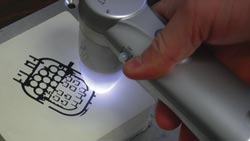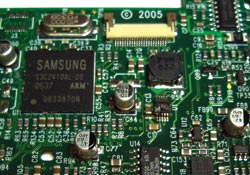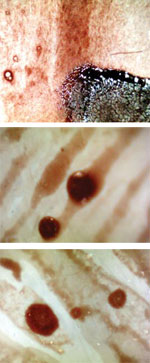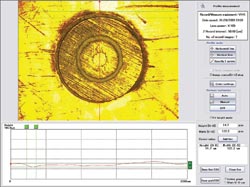Sometimes a picture is worth more than a thousand words – or a thousand dollars. That’s the case for CGI, a company based in Eden Prairie, Minn., which sells proprietary inspection systems for small, plastic injection-molded parts. CGI’s systems slice through these parts and take high-resolution pictures, repeating the process to capture a complete three-dimensional image. That data provides vital information about the manufacturing process, which is why businesses all over the world buy the company’s inspection tools.
But the usefulness of the data depends on the quality of the cut, and that involves trade-offs. A diamond-tipped cutter, for instance, might yield a cleaner slice than a more standard cutter, but it does so at greater cost. CGI president Craig Crump noted that conveying the difference between those cuts is now easier, thanks to handheld microscopes.

A Bodelin ProScope handheld microscope captures a close-up of a part being sliced by a CGI plastic parts inspection system. The image from the microscope illustrates the quality of the cut. Image courtesy of CGI.
“You can describe it verbally, but you don’t capture it nearly as well as you do with one of these little handheld devices,” he said.
That’s just one example of what handheld microscopes are being used for. For those who need a close-up look at something away from the lab, the solution may be at hand – literally. Thanks to advances in imagers, algorithms and optics, handheld microscopes are now available that allow the inspection of components, circuit boards, coins, stamps and skin, meeting the needs of industry and consumers.

Portable microscopes are used for circuit board inspection, as seen here using 20× magnification. Image courtesy of Celestron.
These devices likely won’t replace conventional microscopes, but already they have proved to be useful. A look at offerings from Bodelin Technologies of Lake Oswego, Ore., Keyence Corp. of Osaka, Japan, and Celestron LLC of Torrance, Calif., reveals where handheld microscopy is now and where it’ll be in the future.
With the click of a button
According to CGI’s Crump, the company uses the Bodelin ProScope only for qualitative images. Actual inspection data is captured by digital cameras at a resolution of 1000 pixels per linear inch. The handheld microscope, in contrast, enables easy capture and e-mailing of illustrative images to customers worldwide, thereby showing how one cutting option compares to another. The fact that the handheld microscope captures a visible image is important, since the high-resolution cameras used for the actual 3-D reconstruction also image across the same range.
The ProScope has been around for a decade and has experienced changes in its usage patterns and audience, said Bodelin director of sales and marketing Peter White. It originally started off in science education but has since found a home in manufacturing and law enforcement. Those last two categories now account for the bulk of sales.
“Interpol is one of our customers,” said White, who noted that the FBI and military intelligence likewise use the device for crime scene and other investigations. “We’re also used extensively by private investigators.”
As the market has changed, the ProScope, which White said is manufactured in the US, has undergone technical evolution. Today it has a 1.3-megapixel imager, offers up to 400× magnification and can attach to other optics, making it a possible substitute for the eyepiece found in a conventional desktop microscope. The ProScope takes images with the touch of a button, working with any computer that has a standard USB port. White noted, however, that the best performance comes with a higher-speed USB 2.0 port.
“It’s a UVC plug-and-play product. So there’s no driver,” he added, claiming that to be a key advantage. “It can actually be used live over the Internet.”
The company currently makes a lens set that ranges from 10× to 400×, with another lens of 1000× available to law enforcement only. That restriction may eventually be lifted, in which case the higher-magnification lenses will be sold to the public.
The device includes a mount so that it can be held steady. It also has two imaging modes, one where the focus is fixed at a point such that the device has to touch the object being examined. The second mode provides imaging at a distance of roughly half an inch.
According to White, future possibilities for the product include a device that connects wirelessly to a PDA or handheld computer, which would increase the system’s overall portability. The same flexibility could be achieved by incorporating a computer and display into the microscope. There is a device like this available today from the original developer of the ProScope, Scalar Corp. of Tokyo. Scalar’s DG-3 combines a monitor, a 2.3-megapixel imager and a memory card in a completely untethered digital microscope. However, its cost is much higher than for the ProScope, White said.
The butler did it
One of the applications for current handheld microscopes is in criminal forensics, with uses ranging from fraud to murder investigations. Bodelin recently announced that its product had won the seal of approval of Frank W. Abagnale, one of the world’s leading document fraud investigators and the subject of a Hollywood movie.

Shown is a study determining the sequence of multiple layering of blood for forensic analysis, done using a handheld Bodelin ProScope microscope. Image courtesy of BPA Consulting.
Norman Reeves, a forensic expert who heads Tucson, Ariz.-based BPA Consulting, hasn’t had that kind of publicity, unless you count fictional depictions on crime shows. Reeves specializes in bloodstain pattern analysis, interpreting the shape, location, size and directionality of bloodstains found on clothing and elsewhere. That information can help in defining the location of victim or assailant, as well as in establishing the actions of either or both.
At one time, Reeves did these investigations using conventional microscopes, but these instruments suffered from a lack of portability and often from inferior image quality as well. Today, he works with a handheld microscope. “I can take this with me, lay the evidence out on a table and go to work on it. That’s a great feature.”
Because the data is viewable immediately, he can determine when a particular image should be retaken. He can also quickly send it to a computer, where it can be analyzed later or put into a report. He typically works on a flat surface and uses a stand to eliminate movements that would blur the image.
As is the case with other investigators who have to work with unknown substances, Reeves would like to have the widest possible range of wavelengths available for inspection of material. The ability to image in the infrared and ultraviolet ranges would be useful, as would being able to look with polarized light. For the most part, though, he’s happy with the current technology.
Holding steady
Keyence is another supplier of handheld microscopes. According to project manager Brian Gaehring, the company has been making these products for two decades, with the latest incarnation appearing last year. These systems, according to Gaehring, offer better imaging than those adapted from something intended to be viewed by eye. “The optics and CCD detector work together to provide sharp and clear observation,” he said.

Using a handheld Keyence microscope, NASA researchers profiled a flush-mounted pressure gauge (top) and determined its height relative to a nose cone (bottom), information important in understanding in-flight testing data. Image courtesy of NASA.
That detector is a single-chip, 2.1-megapixel device, but Keyence wrings out of the setup the equivalent performance of up to a 54-megapixel, three-CCD chip. This feat is accomplished with an actuator that moves the chip in the dead time while images are being captured. This approach does have its drawbacks, among them the requirement for a very accurate actuator. But the benefit is substantial in that the technique eliminates the need for an actual three-chip camera or color filter. The former would make the device more cumbersome and expensive. The latter would reduce resolution.
Another feature of the Keyence handheld microscope is a very large depth of field, with the company claiming a depth 20 times that of a conventional optical microscope. This can be useful when inspecting parts because such things as recessed markings, protruding features and complex structures can all be in focus at the same time.
In addition to a stand, the system also has a software solution to combat the shaking that blurs images. Proprietary pattern recognition algorithms distinguish between image movement due to motion of the object being studied and that caused by movement of the microscope itself. Software then corrects for the motion caused by the microscope, thereby stabilizing the image. Gaehring said that the algorithms do this correction well enough to eliminate any apparent motion during handheld inspection. He noted that this adjustment is possible only because of a powerful graphics processor in the system.
Keyence product sales director Sean Gasparovic pointed out that the lighting is controlled by the system and travels over fiber optics to the lens itself. That configuration enhances the microscope’s capabilities, he said. “We can actually create oblique lighting with the touch of a button to help create shadows to capture the texture on the surface.”
Upon closer inspection
The portability of handheld microscopes plays a key role in their use for product inspection and quality assurance. In the case of work done at NASA’s Langley Research Center in Hampton, Va., portability and depth of field were important reasons for using a Keyence handheld microscope.
Margaret Holloman, a NASA quality assurance specialist, was charged with determining the exact profile of a nose cone studded with a large number of flush-mounted pressure gauges. Engineers wanted the instruments to gather data in flight and needed to know the relationship of each gauge to its surroundings.
The situation demanded certain capabilities, Holloman said. “Making noncontact measurements as well as being able to take 3-D images was crucial.”
A conventional microscope couldn’t handle the approximately 3-ft-wide by 6-ft-long wedge-shaped nose cone. In addition, a standard microscope lacks the depth of field necessary for the angled point of view required to determine heights accurately. So Holloman modified a heavy-duty camera tripod and mounted a handheld microscope on it, thereby obtaining the needed 3-D measurements. She also captured a permanent record of the depth and contour of each pressure gauge and its relationship to its surroundings.
Although the nose cone project is done, the system is still in use, with the depth of field an important advantage. “There are times that researchers request complex geometries be measured on a wide variety of flight hardware,” Holloman said.
A final example of handheld microscopy comes from Celestron. Known as a telescope maker, Celestron entered the microscope market with a new line of products last year, part of an effort to increase the company’s revenues in this area. One of the items was a handheld microscope capable of 150× magnification. It has a 1.3-megapixel digital camera and connects to a computer through a USB port.
Unlike some other handheld microscopes, Celestron’s products are aimed at consumers and hobbyists. Some of the uses there include inspection of coins, stamps and other collectibles. There are also both formal and informal educational uses for these handheld microscopes. As with similar products, Celestron’s devices have found application in industrial settings, noted Alan Hale, the company’s vice president of product development.
At Celestron itself, occasional problems with a circuit board have led to an examination using the company’s own products. In those cases, the portability of the microscope was important in that the inspection could occur in place.
Equally important, though, was the device’s ability to make the information visible. It thereby rendered something that was physically small, but that in manufacturing was having a large impact, big enough for a group to diagnose and fix. Recalling the situation, Hale said, “We’ve had three or four engineers standing around, looking at this thing on the screen.”